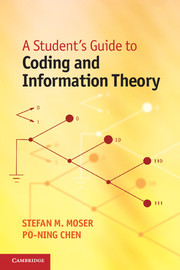Book contents
- Frontmatter
- Contents
- List of contributors
- Preface
- 1 Introduction
- 2 Error-detecting codes
- 3 Repetition and Hamming codes
- 4 Data compression: efficient coding of a random message
- 5 Entropy and Shannon's Source Coding Theorem
- 6 Mutual information and channel capacity
- 7 Approaching the Shannon limit by turbo coding
- 8 Other aspects of coding theory
- References
- Index
3 - Repetition and Hamming codes
Published online by Cambridge University Press: 05 June 2012
- Frontmatter
- Contents
- List of contributors
- Preface
- 1 Introduction
- 2 Error-detecting codes
- 3 Repetition and Hamming codes
- 4 Data compression: efficient coding of a random message
- 5 Entropy and Shannon's Source Coding Theorem
- 6 Mutual information and channel capacity
- 7 Approaching the Shannon limit by turbo coding
- 8 Other aspects of coding theory
- References
- Index
Summary
The theory of error-correcting codes comes from the need to protect information from corruption during transmission or storage. Take your CD or DVD as an example. Usually, you might convert your music into MP3 files for storage. The reason for such a conversion is that MP3 files are more compact and take less storage space, i.e. they use fewer binary digits (bits) compared with the original format on CD. Certainly, the price to pay for a smaller file size is that you will suffer some kind of distortion, or, equivalently, losses in audio quality or fidelity. However, such loss is in general indiscernible to human audio perception, and you can hardly notice the subtle differences between the uncompressed and compressed audio signals. The compression of digital data streams such as audio music streams is commonly referred to as source coding. We will consider it in more detail in Chapters 4 and 5.
What we are going to discuss in this chapter is the opposite of compression. After converting the music into MP3 files, you might want to store these files on a CD or a DVD for later use. While burning the digital data onto a CD, there is a special mechanism called error control coding behind the CD burning process. Why do we need it? Well, the reason is simple. Storing CDs and DVDs inevitably causes small scratches on the disk surface.
- Type
- Chapter
- Information
- A Student's Guide to Coding and Information Theory , pp. 31 - 54Publisher: Cambridge University PressPrint publication year: 2012

